Gold and Silver Investors Greatest Secret Weapon
Commodities / Gold and Silver 2013 Jul 18, 2013 - 04:01 AM GMTBy: Steve_St_Angelo
 As the FED turns up the heat in the central bank frying pan, the frogs (public) don't realize they are being cooked to death by inflation. I am quite amazed how loud the sizzling sound has become, but for some odd reason hardly anyone notices it.
As the FED turns up the heat in the central bank frying pan, the frogs (public) don't realize they are being cooked to death by inflation. I am quite amazed how loud the sizzling sound has become, but for some odd reason hardly anyone notices it.
Unfortunately, we are well past the point of no return. It's only a matter of time now before the whole "Financial Cliff" falls off the mountain side. Until then, gold and silver investors will have to put up with some of the worst analysis ever to come out of government and MSM.
You see this is quite amazing when we consider that just a few generations ago, gold and silver were the two most important monetary metals used in the economy. Gold's strategic role was shown when Roosevelt confiscated the precious metal in 1933 and revalued it to supposedly save the economy.
However, any mention of the subject of gold today to any of the members at the Fed or U.S. Treasury during a public hearing, and you will hear a subtle laugh or snicker as they explain it's just a traditional piece of metal taking up space in central bank vaults. Of course, down deep they believe the opposite, but when their job is cooking frogs for a living, the less the public knows... the better.
ENERGY: The Precious Metal Ally & Secret Weapon
While the Fed has been spending a great deal of time printing money, buying Treasuries and talking out of both sides of its mouth to keep the public's faith placed firmly into the disintegrating fiat monetary system, the fundamental values of gold and silver just keep on baking in the oven.
Sure, both the paper price of gold and silver have tanked recently, but this is a temporary situation. The one fundamental force that the FED cannot manipulate in the future, is the "Store of Value" that is locked into each ounce of gold and silver.
Another way of calling the value stored in precious metals is its "Economic Energy", coined by Mike Maloney which he describes in his video, "Hidden Secrets of Money: Money vs Currency." I highly recommend the video because it simplifies the whole complex matter of money vs. fiat currency.
Furthermore, the video points out that we mistakenly label the Dollar as money, when in fact it should be correctly called as just a currency. Gold and silver are money because they function as a currency and as a store of value. A Federal Reserve Note does not have a store of value, unless you want to attribute a few cents to the high cost of its printing.
There is a reason why the rest of the world is buying gold hand-over-fist as the paper price continues to fall. Gold contains a certain amount of this "Economic Energy", which I label as "Trade-Able Energy Value" that is based upon the energy that runs the overall economy.
Gold & Silver vs. A Barrel of Oil
One way to understand this "Economic Energy" is to see how the value of gold and silver relate to a barrel of oil. Most economists today, make future forecasts based on superficial data and information. For some strange reason, the energy equation seems to be missing from this analysis.
Many of these government economists believe all we have to do to "Increase Jobs" is to stimulate the economy. Do any of these economists ever consider whether or not there will be a growing energy supply in the future to support these increased jobs? Of course not. This is the biggest problem with status quo economists -- making forecasts without including the all the tangential factors.
It seems as if the Ivy League Business Professors view the macro economy in the same way as an individual in the big city believes food comes from the refrigerator. The business schools focus on finance and monetary policy is incorrect... because,
ENERGY IS THE DRIVER OF THE ECONOMY, not finance
Finance is supposed to steer the economy on a healthy path, but due to the fact that this power is in the hands of the corrupt Central Bank Fiat Monetary Authorities, we are heading towards a chain reaction collision.
If we look at the chart below, we can see how the price of silver stacked up against oil and the Dow Jones Average at the time. In 1928, a barrel of oil cost $1.17 while silver was $0.58. As the brunt of the depression hit the U.S. economy in 1932, the price of oil declined to $0.87 and silver fell more than half to $0.25.
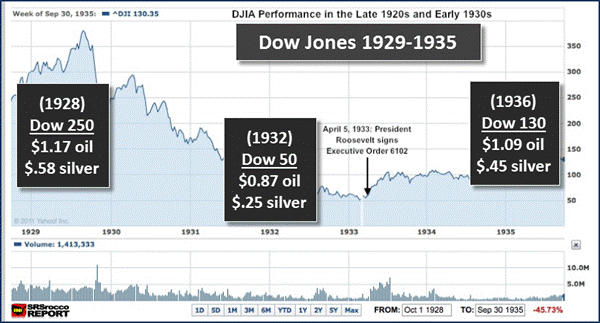
As conditions in the economy started to recover (supposedly), we can see both the price of silver and oil increased in 1936. This next chart takes the ratio of the price of silver compared to a barrel of oil during these same years.
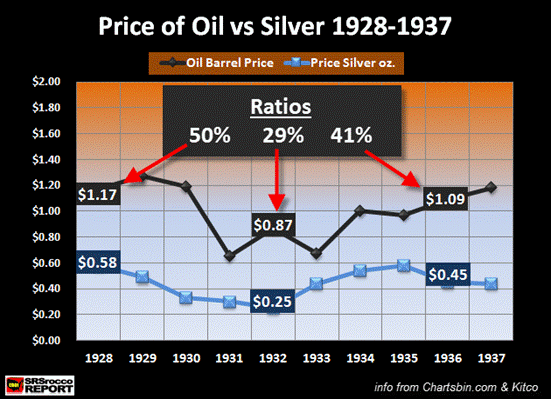
In 1928, an ounce of silver (not its denominated coin value), was worth 50% compared to the price of a barrel of oil. By 1932 this declined to 29% and then rose back up to 41% by 1936. Keep in mind these ratios, as we will compare these to the present ratios a little later in the article.
What took place during this time was the typical textbook definition of deflation -- a decline in the money supply. As economic activity decreased so did the money supply as well as the value of silver, oil and commodities.
Furthermore, in the first chart you will notice that as the Dow Jones average declined from 250 points in 1928 to 50 in 1932, the price of oil and silver declined along with it. Also, as the Dow Jones average rose up to 130 points in 1936, both the price of oil and silver increased as well.
Again, what occurred during the 1930's depression was typical of a deflationary outcome in an economy that was based on sound money. Unfortunately, today, we have a much different animal.
This chart below shows how a fiat monetary system, controlled by central banks can totally distort values of the physical economy.
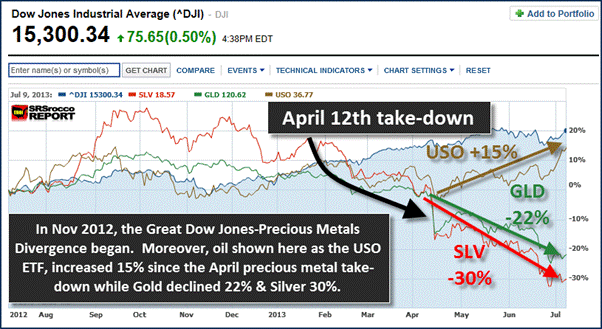
This chart compares the present Dow Jones average to the GLD, SLV and USO (oil ETF). The SLV is shown in RED, the GLD is in GREEN, and the USO oil ETF is in BROWN. After the QE3 announcement by the FED in Sept 2012, you will notice how all the indices increased with silver and gold outperforming both the Dow and the USO.
However, something changed at the beginning of Dec, 2012. The SLV and the GLD peaked and have continued to decline as of the date of this chart, July 9th. In contrast, the Dow Jones average is much higher by gaining 2,400 points or 19% in the same time period.
The huge divergence especially takes place after the April 12th take-down of both gold and silver. Here we can see that the USO, which was paralleling gold and silver's move lower, abruptly disconnected and headed 15% higher since April 12th. On the other hand, the SLV was knocked down 30% and the GLD 22%.
Now, getting back to the silver-oil ratio, this next chart shows how much the buying power of silver in regards to oil has changed presently.
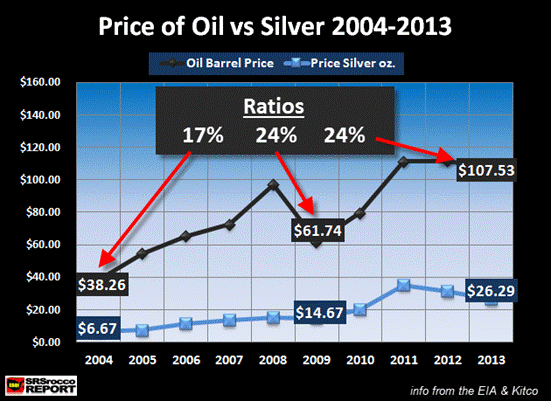
In 2004, the average price of silver was $6.67 which was 17% compared to the price of a barrel of oil ($38.26). As the world's economies fell into a severe recession, the average price of oil declined from nearly $100 a barrel in 2008 to $61.74 in 2009. However, the price of silver declined much less in percentage terms from $14.99 in 2008 to $14.67 in 2009. Thus, the silver to oil ratio actually increased to 24% where it remains presently in 2013.
If we compare the prices of silver and oil from the 193o's to today, we have the following:
SILVER-OIL RATIO
1936 = 2.4 oz of silver to purchase a barrel of oil
2013 = 4.1 oz of silver to purchase a barrel of oil
For the price of silver today to equal the same ratio to oil as it was in 1936, an ounce of silver would be worth $44.09. However, that price will turn out to be very conservative in the future when we factor in the huge amount of industrial demand as well as the smaller above ground available stocks today compared to gold. Now, if we do the same with gold, this would be the result:
GOLD-OIL RATIO (Gold at $20.67 in 1932 & $35 in 1936)
1932 = 24 barrels of oil would equal an oz of gold
1936 = 32 barrels of oil would equal an oz of gold
2013 = 14 barrels of oil would equal an oz of gold
Here we can see that an ounce of gold could purchase 10 more barrels of oil in 1932 (before the revaluation in 1934 to $35) than it does today. If gold had the same buying power in regards to oil in 1932 as it does today, the price of gold would be $2,576. To get the 2013 ratios for gold and silver, I used the current average 2013 price per Kitco (silver was $26.29 and gold was $1,503)
Gold & Silver are Regaining their Monetary Status
Now, these last two charts will show evidence that gold and silver are in the process of regaining their monetary status. From the information provided from the charts and figures above, gold and silver could purchase a great deal more oil in the 1930's than today. Here again are the gold and silver ratios for quick reference:
1936 = 2.4 oz of silver to purchase a barrel of oil
1932 = 24 barrels of oil would equal an oz of gold
(Note: I selected 1936 for the silver ratio as it was a more normal ratio after the lows reached during the depression, and 1932 for gold because it was before its revaluation in 1934)
In the first chart we can see how the price of silver and oil are rising together, but if we look at the ratio shown in the red bars, it has been trending lower.
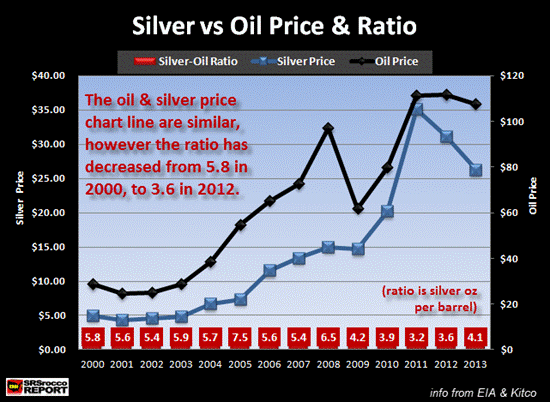
In 2000, it took 5.8 ounces of silver to purchase a barrel of oil, but by 2012, this had fallen to 3.6 ounces. In 2013, after the 40% take-down in the price of silver while the value of oil increased, it now takes 4.1 oz of silver to buy a barrel of Brent crude.
The same thing is also taking place with the value of gold. In the chart below, gold is also rising along with oil, however its gold-oil ratio is increasing in value. The higher the ratio, the more barrels of oil can be purchased with an ounce of gold.
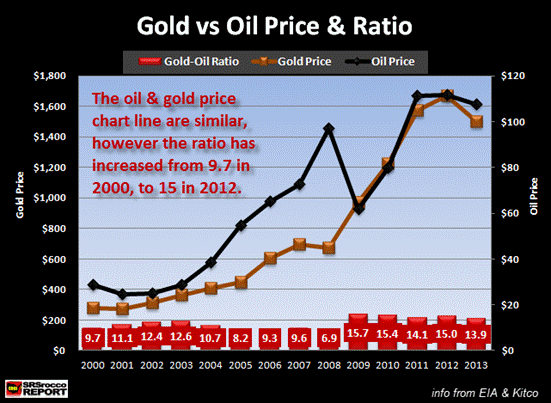
The ratio of gold to oil increased from 9.7 in 2000 to 15 in 2012. Thus, a person holding an ounce of gold in 2012, could buy more than 5 barrels of oil than he could with the same ounce in 2000. Furthermore, if the price of gold wasn't taken down severely in 2013 (as was silver), its present ratio to oil (13.9 to 1) would been nearly 15 to 1.
Even though the precious metals oil purchasing power was greater in the 1930's we are seeing that the average trend is moving higher. I believe what we are witnessing here is the remonetization of both gold and silver shown by their ratio to oil.
The Fed Can Print Money, But not Barrels of Oil, Gold or Silver
While it's true that markets can be manipulated for a while, ultimately the fundamentals win out in the end. As I mentioned in the beginning of the article, most economists have no idea how energy impacts the markets. Oil is by far one of the most important energy sources and without it the world's economies would grind to a halt.
The world is presently experiencing a plateau of global oil production and it looks as if the downside of the inevitable slope of depletion is not too far at hand. This is a serious problem when we consider that the majority of investments in the world are actually HUGE PAPER DEBTS (energy IOU's), masqueraded as assets.
Yes, I do realize many analysts (even those from the Austrian School) believe the U.S and world has trillions of barrels of unconventional energy resources that we can tap into. Unfortunately, these analysts do not understand the concept of falling EROI - Energy Returned on Invested and its impact on these low quality energy sources.
Furthermore, the U.S. Shale Industry has been a total "Commercial Failure" as the top shale energy companies are spending 2-4 times their cash flow on Capex just to keep the illusion of sustainable growth. I am completely amazed how analysts think shale oil & gas wells that suffer 40-50% annual decline rates are going to be the key to solving our energy problems.
I keep reminding readers, that in order for an individual's 401k, retirement plan, pension plan, annuity, long-term bonds or etc to be satisfied or repaid in the future, energy has to be burned to create profitable economic activity. Furthermore, this has to predicated upon a growing energy supply, or global GDP will decline and the whole paper house of cards comes tumbling down.
Unfortunately, we will not have a growing energy supply for much longer, which means the days of the Fiat Dollar are numbered. This is precisely why the present FED policy of printing money, buying bonds and other assorted pieces of paper garbage will not work for much longer.
The FED is not only pushing on a silly string, it's also coming up against the GREAT ENERGY WALL. Energy is the precious metal investors greatest secret weapon because the Fed's fiat monetary powers become increasingly worthless in a peak energy environment.
Without trying to sound like a broken record, energy is the key to understanding the true fundamental values of gold and silver. All I can say to the people of the world who are still holding onto upwards of a $100 Trillion in paper assets, time is running out to make the switch into physical assets such as gold and silver.
One of the most important aspects of the economy is ENERGY. We discuss how energy will impact the precious metals, mining and the overall economy at the SRSrocco Report.
At the SRSrocco Report, we will explore how energy will impact the mining industry in the future. Falling ore grades and decreasing yields are only part of the problem. As net oil exports continue to decline, energy prices will rise putting more pressure on the mining industry. Thus, rising energy costs will guarantee rising prices of gold and silver.
© 2013 Copyright Steve St .Angelo - All Rights Reserved Disclaimer: The above is a matter of opinion provided for general information purposes only and is not intended as investment advice. Information and analysis above are derived from sources and utilising methods believed to be reliable, but we cannot accept responsibility for any losses you may incur as a result of this analysis. Individuals should consult with their personal financial advisors.
© 2005-2022 http://www.MarketOracle.co.uk - The Market Oracle is a FREE Daily Financial Markets Analysis & Forecasting online publication.



